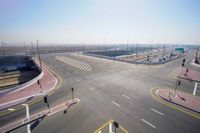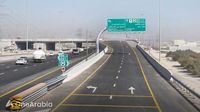Dubai’s Roads and Transport Authority (RTA) has officially opened a new 1.8 km signal-controlled flyover on Al Yalayis Street, a development aimed at enhancing traffic flow to and from Dubai Investment Park (DIP). The inauguration, which took place on Saturday, April 26, 2025, is a significant step in improving transportation infrastructure in the area.
The new flyover, which features a three-lane capacity, is designed to alleviate congestion on Al Yalayis Street, facilitating smoother movement for vehicles entering and exiting DIP. It includes right-turn slip roads for vehicles approaching from Dubai, as well as for those exiting towards Sheikh Zayed Road, making access to and from the park more efficient.
According to the RTA, the construction of this flyover is part of a broader commitment to ensure the seamless operation of trains on the UAE's national railway network. The flyover allows trains to travel within the median strip of Al Yalayis Street while maintaining a separate level for vehicle traffic, effectively optimizing both train and vehicle movement. "This development aims to optimise traffic movement and enhance road safety for all users," the RTA stated.
In addition to its immediate benefits, the flyover is set to undergo further expansion in the future. Plans are already in place to extend the structure towards the Jumeirah Golf Estates, which will involve constructing a two-lane road in each direction. This extension aims to improve connectivity within the road network and ensure a smooth flow of traffic to and from this vital area.
Etihad Rail, the developer and operator of the UAE's national railway network, has expressed its ongoing commitment to collaborating with relevant authorities to align operations with the highest global standards. The organization emphasized the importance of providing efficient transport services for both goods and passengers, ensuring connectivity and the effective delivery of railway services.
"The opening of the flyover will further facilitate the movement of trains, particularly by linking vital routes that enhance mobility to and from the Emirate of Dubai," Etihad Rail stated. This infrastructure project is seen as a key contributor to the UAE's strategic development goals, enhancing the sustainable transport system and enabling the efficient movement of goods and passengers through modern, safe, and reliable trains.
The collaboration between RTA and Etihad Rail underscores the significance of this flyover as a crucial part of the national railway network. It not only aims to improve traffic flow but also supports economic growth across the country by enhancing the movement of goods and strengthening social bonds.
As the RTA continues to develop infrastructure that supports both road and rail transport, the successful opening of this flyover reflects a commitment to innovation and modernization in Dubai's transportation landscape. The authority aims to ensure that both trains and vehicles can operate efficiently without interference, thereby optimizing traffic management in the area.
This flyover is just one example of how Dubai is investing in its future, focusing on creating a comprehensive transport system that meets the needs of its residents and visitors. With the addition of this infrastructure, the RTA is taking significant steps towards achieving its goal of a seamless and integrated transport network.
As the city continues to grow and evolve, projects like this will play a crucial role in maintaining efficient connectivity within Dubai and beyond. The successful implementation of the flyover on Al Yalayis Street marks a significant milestone in the ongoing efforts to enhance the overall transportation experience in the UAE.
In conclusion, the new flyover not only improves traffic conditions but also symbolizes Dubai's commitment to sustainable development and effective transport solutions. With plans for future expansions and ongoing collaborations with Etihad Rail, the RTA is poised to continue making strides in enhancing the transport infrastructure in the region.





